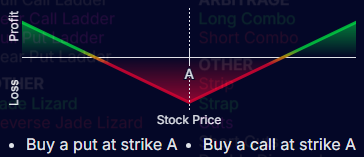This is precisely the moment when options trading moves from the level of “strategy” to the level of structural risk management.
First, let’s figure it out – is it possible to create a completely risk-free option combination?
In the classical sense, no. It is not possible to create a 100% risk-free position (if we do not take into account arbitrage or bad pricing). In reality, there’s no truly risk-free option strategy from the start. Every trade has exposure to price, time, or volatility.
But there are situations when a position, after the market has moved, can be converted into a “risk-free” one, i.e.:
- all the initial risk is removed (because you are already in profit);
- you leave part of the open position, but now for profit;
- and now you really “don’t care” where the market goes – the deal will either bring a profit or you won’t lose anything.
How Does It Work in Practice?
1. The first step is to open a position on movement (or volatility)
For example, you buy a Long Straddle* (Call + Put) on AAPL at $200 before the news. You pay, say, $10 for the entire combination.
- Buy 200 Call $5
- Buy 200 Put $5
- Total cost = $10

*A straddle is an easy to understand volatility strategy that allows you to profit from moves in either direction. Since it involves buying both a call and a put, it is an expensive strategy and needs a big move to cover its cost.
Time is harmful to this strategy since it is made up of long options, but volatility is your friend. You may consider buying a straddle before earnings to profit off any big move after earnings (but keep IV crush in mind!), or to take advantage of the rising IV before earnings.
2. The price moves and one side becomes profitable
Let’s say a few days later, AAPL jumps to $210: In this scenario, your Call has already risen in price, and the Put has fallen significantly in price.
For example:
- The Call is now worth $11.
- The Put has fallen to $1.
Total cost = $12. That means you are $2 in profit ($12-$10) relative to the start.
3. Take partial profits to remove the initial risk
Creating a “risk-free” position. You sell the Put for $1 and part of the Call for $1 to get your $10 capital back. Now, you’re left with, say, 0.8 Call in a position that’s totally free. From that moment, if AAPL goes higher, you will get even more profit. If AAPL falls, If the price falls, you will not lose anything (because you have already “taken your money back”). All your invested capital has been returned. This idea is often called creating a risk-free trade, or as many traders say: “I took the risk off the table.”
4. Other variants for creating a risk-free combination
| Method | How it works | Typical Use |
| Lock in profit from Long Straddle / Strangle | Close part of the winning leg after a move | Volatility events, news trades |
| Turn Long Call into Vertical Spread | Sell higher strike once in profit | Trend continuation |
| Iron Fly / Iron Condor adjustment | Close the losing side using profit from the winning side | Range breakout |
Example: Turning a Call into a free Vertical Spread
Let’s say you bought a Call AAPL 200 Call for $5. After a nice rally, the same Call is now worth $9. You can sell the 210 Call for $4.
Now:
- You’ve received $4,
- Your net cost = $5 − $4 = $1,
- And you can even sell enough to recover that last $1 – making your position completely free.
Then, you hold a Bull Call Spread** (200/210) that costs nothing. It can’t lose, but can still earn up to $10 − $0 = $10 per share if AAPL will go above $210.

**A bullish vertical spread strategy which has limited risk and reward. It combines a long and short call which caps the upside, but also the downside.
The goal is for the stock to be above strike B at expiration. This strategy is almost neutral to changes in volatility. Time-decay is helpful while it is profitable, but harmful when it is losing.
Important Note
Risk-free options are not created at the outset – they are achieved through position management.
- First, you take a controlled risk (premium).
- Then the market moves in your favor.
- You “take back” your investment, leaving the rest to work without risk.
In other words, a truly risk-free position is not a strategy, but a stage of managing a profitable position.
Final Thoughts
It is impossible to create a “completely risk-free” options combination at the start, because all options factor risk into their price. However, it is possible to turn a winning position into a risk-free one with the right fixation and management. This is one of the most powerful skills in professional trading. When you learn to remove risk from your profitable trades, you stop being a predictor and start being a risk engineer.




